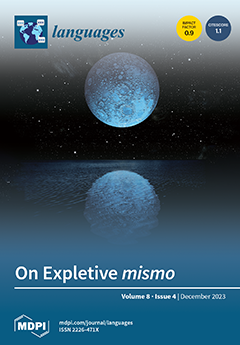Romance free choice items (FCIs) are frequently pointed out as resulting from the grammaticalization of the relative determiner
qual ‘which’ and an element derived from a volition verb, such as
querer ‘want’. Contrary to other Romance FCIs, Portuguese
qualquer ‘any’ remains understudied, therefore
[...] Read more.
Romance free choice items (FCIs) are frequently pointed out as resulting from the grammaticalization of the relative determiner
qual ‘which’ and an element derived from a volition verb, such as
querer ‘want’. Contrary to other Romance FCIs, Portuguese
qualquer ‘any’ remains understudied, therefore motivating the current research. In this article, I investigate the syntax and semantics of
qualquer, from a diachronic perspective, based on examples extracted from 13th and 14th century texts. Analysis of contexts of occurrence of
qualquer showed that, in Old Portuguese, the elements
qual and
quer could combine in different configurations, corresponding to different structures. On the one hand, the relative determiner
qual could combine with a form of the volition verb in
ever free relative clauses. On the other hand,
qual and
quer were also combined in appositive relative clauses, which seem to be at the core of postnominal
qualquer. However, similar to what is argued for Old Spanish,
qualquer was also a quantifier-like element, occurring in prenominal position and giving rise to universal interpretations. The different origins of prenominal and postnominal
qualquer may help explain the different readings in contemporary data.
Full article





